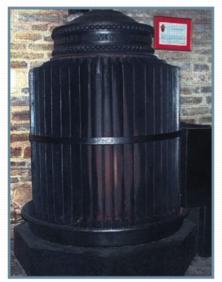The Gurney stove

Warm-air heating with humidification — the largest Gurney warm-air heater could heat a space of 120 000 ft3.
Goldsworthy Gurney (later Sir) was born in Cornwall in 1793. In 1814, he settled in Cambourne where he practised as a surgeon, moving to London in 1820 and developing his interest in engineering. In 1825 he patented a steam carriage, going on in 1842 to patent a system of heat recovery from lighting fittings. In 1852, Gurney was appointed to investigate the ventilation problems in the House of Commons where he flashed off large quantities of gunpowder in the chamber to observe the motion of the air currents, He was said to have posed a greater risk than Guy Fawkes! His interest in heating led him to invent a new type of warm-air stove, which he patented in 1856 as ‘Certain Improvements in warming and moistening air’. The apparatus was described as a metallic vessel having a number of plates extending from its outer surface, standing with the plates vertical in a shallow trough of water. This was significant in attempting to provide humidification to offset the drying feeling caused by warm air. He soon after sold the rights for his invention to the London Warming & Ventilating Company which advertised itself as ‘Proprietors of the Gurney stove’ and remained active in the 1950s. The stove was made in three sizes, the largest being 1 m in diameter with a 1.8 m diameter base and of 2.7 m high. It consumed about 200 kg of coke a week and was said to be capable a heating a space of 120 000 ft3. It was very heavy, at a time when there was a popular belief that heat output depended on the mass of metal in the stove. By 1897 (the year of the founding of the IHVE) a London Warming advertisement claimed ‘over 10 000 churches, schools, government and other public and private buildings successfully warmed by our system’. This included some 22 cathedrals; working examples (converted from solid fuel) can still be seen in Hereford, Chester and Ely Cathedrals and in Tewkesbury Abbey.


